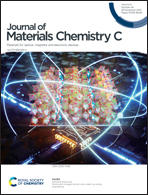Organic clusters with time-dependent color-tunable dual persistent room-temperature phosphorescence†
Abstract
Luminescence from organic clusters has gained increasing interest recently because of their distinct emission characteristics compared with the monomer, such as color tunable emission with different wavelength excitations. Herein, we reported three lactams with different ring-members of heterocyclics: indolin-2-one (OID), 3,4-dihydroquinolin-2(1H)-one (OID-6) and 1,3,4,5-tetrahydro-2H-benzo[b]azepin-2-one (OID-7) with dual persistent room-temperature phosphorescence (p-RTP) in the crystalline state owing to the formation of clusters. Due to the dual p-RTP with different but comparable phosphorescence lifetimes of multiple triplet states, it is of interest that OID-6 and OID-7 exhibit time-dependent afterglow color emissions from blue to green to yellow, and this is the first report on organic crystalline clusters with time-dependent color-tunable dual persistent room-temperature phosphorescence. The longest phosphorescence lifetime and the highest photoluminescence quantum yield among these three compounds were observed for OID-7 with the most twisted molecular configuration, owing to the simultaneously suppressed triplet quenching and intramolecular vibrational relaxation by the small orbital overlap due to its weak π–π stacking and strong intermolecular hydrogen bonding interactions in the crystalline state.



 Please wait while we load your content...
Please wait while we load your content...